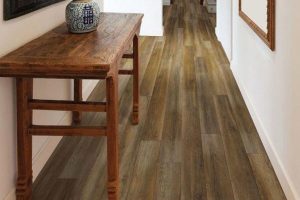Gather Your Tools and Materials
Gathering the necessary tools and materials is the first crucial step in removing glass block windows safely and effectively. Before you begin the project, make sure you have the following items on hand:
- Safety Gear:
- Safety goggles: Protect your eyes from flying debris.
- Heavy-duty gloves: Shield your hands from sharp edges and glass fragments.
- Dust mask: Prevent inhaling dust and particles during the removal process.
- Demolition Tools:
- Hammer: Used for breaking glass blocks and loosening mortar.
- Chisel and masonry bit: Essential for removing stubborn mortar.
- Pry bar: Helps in gently removing exterior trim or casing around the window frame.
- Utility knife: Useful for cutting through caulking and sealants.
- Cleaning and Disposal:
- Broom: For sweeping up debris and glass shards.
- Vacuum cleaner with a HEPA filter: Ensures thorough cleaning and minimizes dust.
- Trash bags or containers: For safe disposal of broken glass and debris.
- Measuring and Replacement:
- Measuring tape: Allows for accurate measurements of the window opening.
- Replacement glass blocks (if necessary): Ensure they match the size and style of your existing blocks.
- Mortar and Installation:
- Mortar mix: Required for securing the new glass blocks in place.
- Trowel: Used for applying mortar evenly.
- Caulk and caulking gun: For sealing gaps and finishing touches.
- Screwdriver: May be needed for removing any fasteners.
- Finishing Touches:
- Paint and paintbrush (if applicable): Used for restoring the exterior appearance after installation.
- Additional Safety Precautions:
- Sturdy shoes: Protect your feet from potential hazards.
- Appropriate clothing: Wear clothing that covers your arms and legs to prevent injuries.
Safety First: Protecting Yourself
Safety should always be your top priority when working on home projects. Wear safety goggles, gloves, and a dust mask to protect yourself from flying debris and dust. Make sure you are wearing appropriate clothing and sturdy shoes.
Removing the Exterior Frame
- Safety First:
- Before you begin, put on your safety gear, including safety goggles and heavy-duty gloves, to protect your eyes and hands from potential hazards.
- Assess the Frame:
- Carefully inspect the exterior frame of your glass block window. Identify any screws, nails, or fasteners that are securing it to the surrounding structure.
- Remove Any Trim or Casing:
- If there is any exterior trim or casing around the window frame, use a pry bar and a screwdriver to gently remove it. Take your time to avoid damaging the surrounding structure.
- Locate and Remove Fasteners:
- Look for screws or nails that are holding the frame in place. Using a screwdriver, pry bar, or appropriate tool, carefully remove these fasteners. Start with the top and work your way down.
- Gently Pry the Frame:
- Once the fasteners are removed, gently pry the exterior frame away from the wall. Use a pry bar or a flat-edged tool to create separation between the frame and the wall.
- Work Gradually:
- Be patient and work gradually, moving along the frame’s perimeter. Avoid using excessive force to prevent any damage to the frame or the wall.
- Inspect for Sealant:
- Check if there is any sealant or caulking between the frame and the wall. If so, carefully cut through it with a utility knife to facilitate the frame’s removal.
- Continue Removing the Frame:
- Continue prying and removing the frame until it is completely detached from the wall. Take care not to damage the surrounding area.
- Dispose of the Frame:
- Once the frame is removed, dispose of it properly. Check local regulations for disposal guidelines, as some areas may require specific disposal methods for construction materials.
- Clean the Area:
- After the frame is removed, clean the area around the window opening. Remove any debris, nails, or screws to ensure a clean and safe working environment for the next steps in the glass block window removal process.
Loosening the Mortar
Using a hammer and chisel, gently tap around the mortar joints of the glass blocks to loosen them. Start from the top and work your way down, taking care not to break the glass during this process.
Breaking the Glass Blocks
Once the mortar is sufficiently loosened, carefully break the glass blocks using a hammer. Ensure that you are wearing safety goggles to protect your eyes from any shards.
Removing the Mortar from the Opening
Use the chisel and masonry bit to remove the remaining mortar from the window opening. Take your time and work methodically to clean the area thoroughly.
Cleaning Up the Debris
Dispose of the broken glass and debris safely. Use a broom and vacuum cleaner to clean up the area, ensuring no small shards or dust particles are left behind.
Measuring the Opening
Measure the opening carefully to determine the size of the replacement windows you’ll need. Accurate measurements are crucial for a proper fit.
Selecting Replacement Windows
Choose replacement glass blocks that match the measurements of your opening. Consider the style and design that best suits your home’s aesthetics.
Installing the New Windows

Follow the manufacturer’s instructions for installing the replacement glass blocks. Typically, this involves applying mortar, setting the blocks, and allowing them to dry.
Sealing and Insulating
- Assess the Existing Sealant:
- Begin by inspecting the current sealant or caulk around your glass block windows. Look for any cracks, gaps, or areas where the sealant has deteriorated.
- Remove Old Sealant:
- If you find any damaged or aged sealant, use a utility knife or a caulk removal tool to carefully remove the old caulk. Ensure that you have a clean and smooth surface to work with.
- Select the Right Caulk:
- Choose a high-quality, waterproof silicone or acrylic caulk for sealing the gaps around the glass blocks. Ensure that the caulk is compatible with both glass and masonry surfaces.
- Prepare the Surface:
- Clean the window frame and glass block joints thoroughly. Use a mild detergent and water to remove any dirt, dust, or debris. Allow it to dry completely before proceeding.
- Apply the Caulk:
- Load the caulk into a caulking gun and cut the tip of the nozzle at a 45-degree angle to the desired bead size. Apply a continuous bead of caulk along the gaps between the glass blocks and the frame, ensuring a tight seal.
- Smooth and Shape:
- Use a wet finger or a caulk smoothing tool to smooth and shape the caulk bead. This ensures proper adhesion and a neat finish. Be sure to remove any excess caulk.
- Insulating the Frame:
- Check the frame of your glass block windows for any gaps or drafts. If you detect any, fill them with expanding foam insulation. Ensure that the foam does not expand excessively, as it can warp the window frame.
- Exterior Sealing:
- Examine the exterior of your windows for any gaps or cracks in the mortar joints. Use mortar mix to fill in these gaps, reinforcing the structural integrity and preventing water infiltration.
- Allow Proper Drying Time:
- Follow the manufacturer’s instructions for the caulk and foam insulation regarding drying times. It’s essential to allow adequate time for the sealant to cure and set.
- Paint or Finish as Needed:
- Once the sealant is completely dry, you can paint or finish the window frame to match your interior or exterior decor, if desired.
- Regular Maintenance:
- Periodically inspect the sealed areas for any signs of wear or deterioration. Reapply caulk or insulation as needed to maintain the integrity of the seal.
Adding Finishing Touches
Replace any exterior trim or casing that you removed earlier. Use caulk and a caulking gun to seal any gaps around the window frame.
Maintenance Tips
Maintenance is crucial to ensure the longevity and continued functionality of your glass block windows. Here are some essential maintenance tips to keep in mind:
- Regular Cleaning:
- Clean your glass block windows periodically to remove dust, dirt, and smudges. Use a mild detergent and water solution, along with a soft cloth or sponge, to gently wipe down the surface.
- Inspect Mortar Joints:
- Check the mortar joints between the glass blocks for any signs of wear, cracking, or deterioration. If you notice any issues, address them promptly to maintain structural integrity.
- Recaulking:
- Examine the caulk or sealant around the window frame. If it starts to crack or peel, recaulk the gaps to prevent drafts and water infiltration. Proper sealing is essential for energy efficiency.
- Prevent Water Accumulation:
- Ensure that there is proper drainage around your glass block windows. Make sure the window sill is sloped away from the house to prevent water from pooling.
- Repair Any Damage:
- If any glass blocks become cracked or damaged, replace them promptly. Damaged blocks can compromise both the appearance and functionality of the window.
- Sealing Gaps:
- Periodically check for gaps between the glass blocks and the frame. Fill any gaps with mortar to maintain a secure fit and insulation.
- Interior Maintenance:
- If your glass block windows have interior trim or casing, inspect and maintain it as needed. Paint or refinish the trim to keep it looking fresh.
- Condensation Control:
- In humid climates, condensation may form on the glass blocks. Use a dehumidifier or increase ventilation in the room to minimize this issue.
- Professional Inspection:
- Consider scheduling periodic professional inspections of your glass block windows. An expert can identify potential issues that might go unnoticed.
- Security Checks:
- Ensure that the locking mechanisms on your glass block windows are functioning correctly. This is crucial for both security and maintaining a tight seal.
Additional Tips and Considerations
1. Assess the Structural Integrity
Before you begin the removal process, it’s essential to assess the structural integrity of the surrounding wall. Ensure that there are no hidden issues like rot or water damage that might require additional repairs.
2. Plan for Disposal
Dispose of the broken glass blocks and debris responsibly. You may need to check your local regulations for disposing of glass, as it can be considered hazardous waste in some areas. Consider recycling options if available.
3. Consider Natural Light and Privacy
While glass block windows provide privacy, they also allow natural light to filter through. When selecting replacement windows, think about how much light you want in the room and whether you want to maintain the privacy aspect.
4. Explore Design Options
Glass block windows come in various designs and patterns. Take the opportunity to explore different options that can complement your home’s aesthetics and enhance its overall look.
5. Weatherproofing
Ensure that your replacement glass block windows are adequately weatherproofed. Proper sealing and insulation are essential to prevent drafts and energy loss.
6. Seek Professional Help If Needed
While glass block window removal and replacement can be a DIY project, it’s essential to know your limitations. If you encounter structural issues or feel uncomfortable with certain aspects of the process, don’t hesitate to seek professional assistance.
Frequently Asked Questions
Yes, with the right tools and safety precautions, you can remove glass block windows as a DIY project.
It depends on their condition. If they are damaged or if you want to update the style, consider replacing them.
The timeline varies depending on experience, but it can typically take a day or two.
It’s not recommended, as they may be damaged during removal.
You can install replacement glass blocks yourself if you’re comfortable with DIY projects.
Conclusion
Removing glass block windows can be a DIY project that adds a touch of personalization to your home. By following the steps outlined in this guide and taking the necessary safety precautions, you can successfully remove and replace your glass block windows. Enjoy the enhanced aesthetics and functionality of your updated windows.



